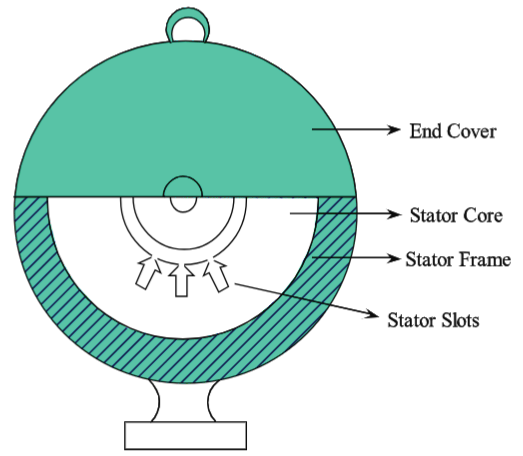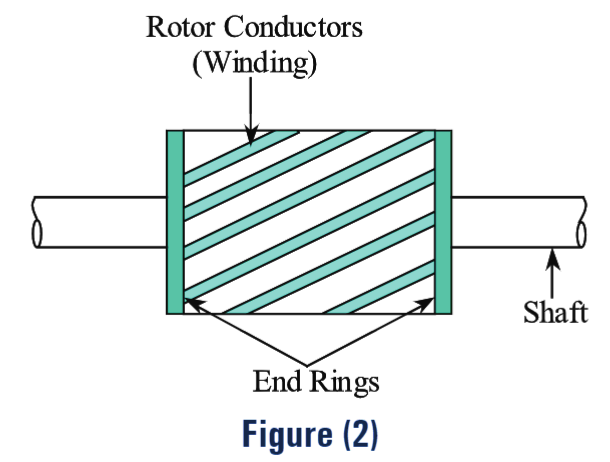A three phase induction motor is an AC motor consisting of a three-phase winding and are used for applications like exhaust fans, lathes, etc.
Working Principle of 3 Phase Induction Motor

A 3 Phase Induction Motor works on the principle of electromagnetic induction. When the three-phase winding of the stator is connected to the three-phase supply, the three phase current in stator winding produces a rotating magnetic field, which rotates round the stator at synchronous speed (NS). This rotating field or flux passes through the air gap and cuts the rotor conductors, since rotor conductors are stationary and flux is moving. As a result of relative speed between the rotating field and stationary rotor conductors, e.m.f is induced in rotor conductors. Since the rotor conductor circuit is closed, current flows in that as a result of induced e.m.f. Thus, whenever a current carrying conductor is placed in rotating magnetic field it produces its own flux. Due to this, a magnetic flux called rotor flux is produced in rotor. Thus, a torque is produced due to the interaction between the air gap flux and the rotor flux. The effect of this torque is that the rotor starts rotating in the same direction as the rotating magnetic field (according to Lenz law) and the speed of the rotor starts increasing from 0 to N.
Since the rotor speed is increased it rotates in the same direction as the rotation of magnetic field and the relative speed between the two decreases. As a result. the induced e.m.f in rotor current and rotor frequency gets reduced and also the torque gets reduced. But the rotor continues to accelerate and gains the speed. Under no-load conditions equilibrium is reached when the developed torque equals the torque due to losses. At equilibrium condition, the motor runs almost at synchronous speed but not equal to synchronous speed. As soon as the motor is loaded, the load torque plus the torque due to losses become greater than the developed torque. Therefore. the motor slows down. However, a reduction in rotor speed means an increase in relative speed as well as rotor current and hence an increase in the developed torque. As a result of this, the developed torque equals load torque plus torque due to losses. Hence equilibrium is reached in loaded condition. The motor then runs at a new steady speed, which is less compared to no-load speed. Thus, the speed ofmthree-phase induction motor varies with the load.
Construction (or Parts) of 3 Phase Induction Motor
The main constructional features of a three phase induction motor are stator and rotor. Usually stator receives three phase supply and working currents are developed in rotor.
Stator

Figure 1.
Stator consists of cast iron stator frame and laminated steel stampings of cylindrical stator core as shown in figure (1). These stator core steel laminations have minimum hysteresis and eddy current losses compared to other materials when alternating current passes through them. Stator core have the slots for inserting the polyphase winding.Slots provided on the stator core are of three types. They are open type, semi-closed type and closed type slots. Closed slots facilitate uniform air gap thereby flux distribution is also uniform. They have a limitation due to their high initial labour cost for winding and their increased winding inductance. Open slots have the advantage of easy removal and replacement of defective coils. But non-uniform air gaps are formed by open slots. Among all the three, semi-closed slots are advantageous because of less ripple content in their e.m.f waveform and less initial labour cost for designing.
Rotor
Induction motors are of two types depending upon the type of rotor used. The two types of rotors are squirrel-cage type and slip ring type.

Squirrel cage type rotor has slots on its outer periphery which are circular in shape. The rotor winding is placed in the rotor slots and its ends are shorted by same winding material known as end rings as shown in figure (2). This facilitates the rotor suitability for any number of stator poles and insertion of external resistance to the rotor winding is not possible. Hence the starting torque of squirrel cage type induction motor is double to that of full load torque only for the application of rated voltage. Squirrel cage induction motors (SCIM) are simple and economical in construction and require less maintenance.

Slip ring type rotor also have slots on its circular outer periphery. The rotor winding which is to be placed in the rotor slots is similar to that of its three phase stator winding so that number of rotor poles are equal to stator poles. Slip ring type of rotors have a facility to insert external resistance at their output terminals as shown in figure (3). Therefore its starting torque can be changed as per the requirement, by placing suitable resistance in the rotor circuit.
Advantages of 3 Phase Induction Motor
The following are some of the advantages of three phase induction motor.
- Simple design
- Low initial cost
- Simple maintenance
- Rugged in construction
- Easy and reliable operation
- High efficiency
- Simple speed control.
Applications of 3 Phase Induction Motor
The following are the various fields of application of three phase induction motors.
- Fans
- Centrifugal pumps
- Lift irrigation
- Rice mills
- Pumps
- Cranes.
Frequently Asked Questions on 3 Phase Induction Motor
Q1. Why an induction motor will never run at its synchronous speed?
Ans1: At starting of induction motor, the rotor rotates and tries to achieve the speed of the rotating magnetic field. But the rotor runs at a speed which is always less than the synchronous speed of the stator field. If there is no difference between the two speeds, then there would be no relative motion, hence no induced E.M.F and no current would flow and thus no torque would be present to maintain rotation. By this action the motor stops and again there exists a relative motion between the rotor and rotating magnetic field and thus the motor starts. Due to inertia of rotor, the rotor rotates at a speed slightly less than the synchronous speed of a rotating magnetic field. Thus an induction motor will never run at its synchronous speed.
Q2. Explain why an induction motor, at no-load, operates at very low power factor.
Ans2: At no-load operation, the magnetizing component, Im of no-load current is much greater than the loss component, Ic of no-load current as shown in figure. Hence, due to this reason an induction motor operates at very low power factor less than 0.4 lagging at no-load condition.
Q3. How can the direction of rotation of 3-phase induction motor be reversed?
Ans3: The direction of rotation of three phase induction motor can be reversed by reversing the connection i.e., if the motor is connected to three phase as RYB then by connecting motor as RBY or YBR, the direction of rotation of induction motor can be reversed.